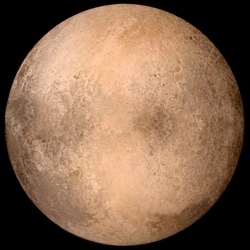
As our Sun gets older, brighter, and bigger over the next several billion years, it will expand into a red giant so large that its heat could melt ice on the surface of Europa and the other moons of Jupiter, as well as those around Saturn. Liquid water flowing freely would provide a stable environment ripe for fostering life.
The bad news is Earth will be burnt to a crisp. It may even get engulfed by the fiery wall of the expanding star, along with Mercury and Venus, so anyone that remains on Earth probably won’t live to see that day.
For right now, however, humans who study planets orbiting other stars stand to benefit from the grim future prospects of our solar system’s innermost planets. A new model of the evolution of stellar systems’ habitable zones, based on what’s expected for our own solar system, could help observers today better evaluate which exoplanets could harbor life.
In a solar system’s habitable zone, enough energy and heat from the central star sustain liquid water on its orbiting planets. Using their new model, researchers at Cornell University’s Carl Sagan Institute in Ithaca, N.Y., have found that the habitable zones around stars that have aged into red giants may exist for perhaps billions of years after the star’s expansion.
In this time span, primordial life could perhaps evolve and flourish, said Ramses Ramirez, a planetary scientist at the institute. Ramirez and colleagues describe their model in a paper published today in the Astrophysical Journal.
Currently, our Sun exists in its main sequence of stellar evolution. A churning engine of nuclear fusion converting hydrogen into helium in its core gives the Sun the fuel it needs to send enough energy hurtling toward Earth to sustain liquid water, a thick atmosphere, and life.
But in the next 7–7.5 billion years, the Sun will run out of hydrogen. The inward pressure of gravity will contract our star, and its internal pressure will allow helium to fuse into heavier elements like carbon, the higher core temperatures will cause the Sun to expand like a hot balloon, possibly to more than 200 times its current size. By the time the Sun is about 12.5 billion years old, it will have transformed into a red giant.
Under those future conditions, moons that orbit Jupiter and Saturn in zones that currently receive about 1/25 and 1/90 the Sun’s energy, respectively, will suddenly be in a habitable zone. Ramirez’s new model found that planets could reside in this new zone for 200 million to 9 billion years. Given that life on our planet took around 500–700 million years to evolve from simple multicellular organisms into more complex forms, Ramirez said, life on the once-icy moons could possibly flourish.
Astronomers learn about exoplanets’ surface compositions by splitting the light emitted by the planet into its component wavelengths, from the smallest gamma rays through the longest radio waves. Patterns over this light spectrum can then be matched to known patterns of emissions produced by various elements or molecules. In this way, scientists estimate the chemical “fingerprint” of an exoplanet’s surface.
So far, those looking for worlds that could harbor life generally search for Earth-like rocky planets orbiting a star’s habitable zone. But if Europa-like analogs exist in other stellar systems, the new study widens the search parameters, opening up new possibilities to consider in systems with older stars, Ramirez said.
The resulting larger pool of exoplanets could then be analyzed to see if their surfaces hold not only water but also gases such as oxygen, methane, and carbon dioxide. Such gases indicate the presence of an atmosphere, which is also important to retaining life.
The trick now, Ramirez said, will be pointing our telescopes in the right direction.
